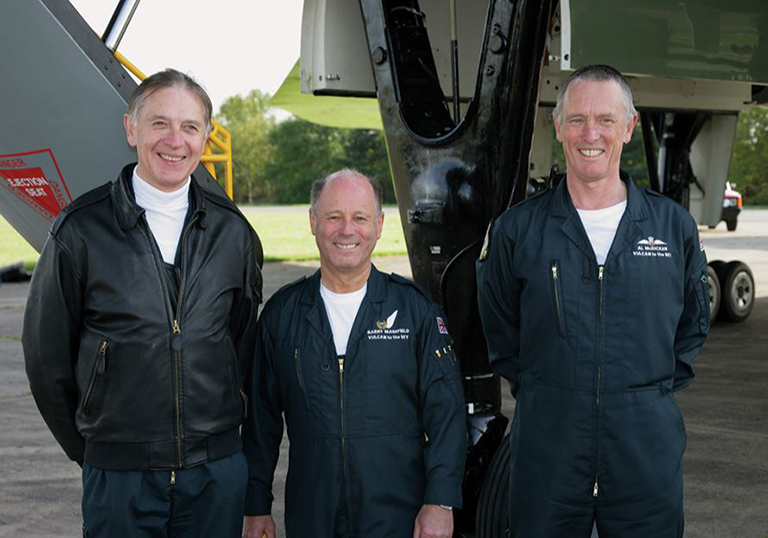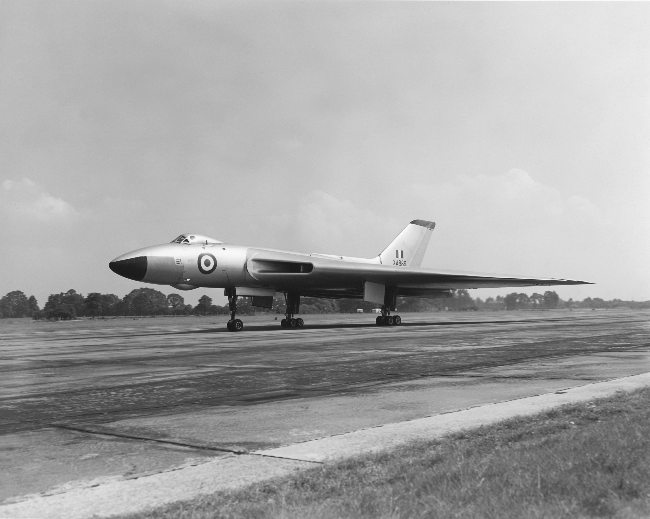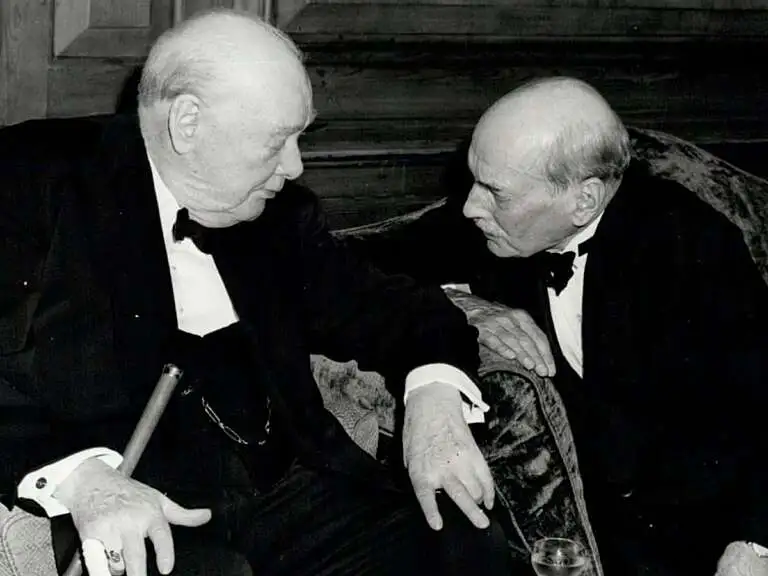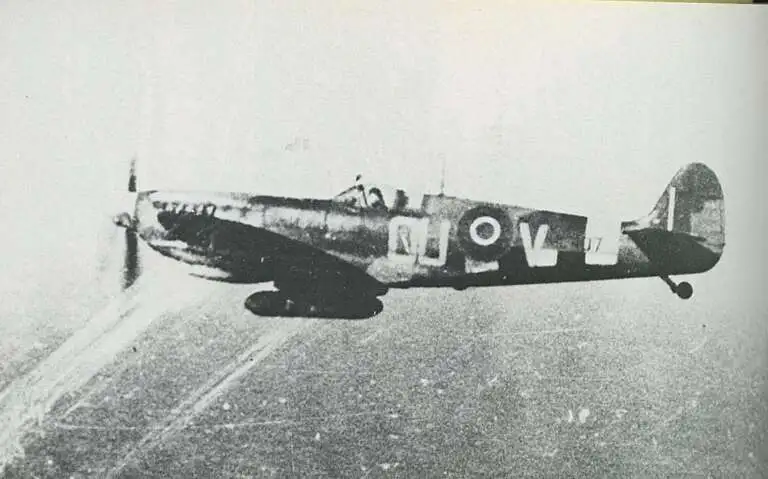
Doomsday Clock
The Doomsday Clock, a symbol created during the early years of the Cold War, serves as a metaphorical representation of the world’s proximity to a global

The waiting was over. At last Taff Stone and his team of engineers had finished sufficient of the winter servicing schedule to enable XH558 to be taken for a test flight. All the hard work of his engineers and the funding provided by our faithful public was now going to be put to the test.
Wednesday 25th April – the aircrew gathered at Robin Hood to complete their annual refresher training involving emergency egress drills. For the uninitiated, this is a drill that we carry out each year before we start our flying season. Essentially, we sit in the aircraft simulating a typical flight profile and then our examiner, Andy Marson who is also our resident navigator, instigates a simulated problem with the aircraft. He invariably intensifies the situation observing our reactions to the unfolding events until finally it becomes apparent that the aircraft is no longer flyable and we either carry out a simulated abandonment from the aircraft while it’s still airborne, or he allows the situation to develop resulting in us landing the aircraft but have to get out of it pretty sharpish because of a simulated engine fire or something equally as alarming. Even though we all know that it’s only an exercise it still gets the adrenaline pumping as we carry out the drills. Having completed the drills, Andy can then sign up all the participants as proficient which will allow us to fly for the next twelve months.
Of course, it was no secret that 558 had been programmed to undergo her post winter service flight test the following day. The crew to fly the air test was led by Kevin Rumens who was also to be the aircraft Captain. He was to be accompanied by Paul Mulcahy who, as many of you will already know, is the CAA chief test pilot. Paul has done all the necessary test flights on XH558 over the past 5 years and is always a welcome visitor to the project. Acting as AEO and ensuring the electrical integrity of the aircraft down the back was Phil Davies. Up until this test flight, I had always acted as the AEO for the test flights, but this was an ideal opportunity to kill two birds with one stone. Each year, I have to fly with Phil prior to the start of the flying season to check his competency to operate the aircraft, so I let him fly on the air test as the AEO while I sat in the Nav. Radar seat, not only monitoring his actions, but also acting as the Flight Test Observer – which involves filling in all the results of the Flight Tests that we were going to be carrying out. We had all met up the previous day to do our drills as previously mentioned, and were all staying in the same hotel at the airport. This was ideal, because it gave us all a chance to catch up with all our individual comings and goings since we had last met at our annual ground refresher school back in February. Needless to say this was over a few beers and a very nice meal in one of the local pubs.
The day of the air test dawned and what an awful dawning it was. As we all assembled for breakfast in the hotel, we could see that it was pouring with rain which didn’t bode well at all. The forecast for later in the day was marginally better, but it was obvious that it was going to be quite late in the afternoon before we could get airborne and even then, it was looking doubtful. However, we pressed on and all made our way to the office to do our pre flight tasks. We received a phone call mid morning from Taff Stone, to say that there was a minor delay until a man at Rolls-Royce had inspected some photographs taken of the inside of one of the engines, and it was unlikely that he would give us his verdict until early afternoon. Hopefully, he would be like the man from Del Monte and say “Yes” we could fly.
As could be expected, there was a large gathering of the media who had come to witness the air test and Richard Clarke, our PR man, asked that Martin Withers, Andy Marson and myself, make ourselves available for interviews. Not only were the media there to capture the air test, but to do interviews with us all about the 30th Anniversary of the Falklands War. As you will be aware, Martin and I flew the bombing missions but Andy was instrumental in planning the raids while working behind the scenes at RAF Waddington. Unfortunately, I had to leave before I could be interviewed, but Martin and Andy held the line and chatted for quite a long time. Meanwhile, I had to make my way back to the office to attend the crew briefing. There looked to be a window of opportunity developing where the weather was going to clear and if we could get the air test briefing completed, all we had to do, was then wait for Taff’s man from Del Monte to say “Yes”, and we could get the air test underway with the minimum of delay.
We waited patiently and then eventually we got the clearance from Rolls-Royce which would allow us to fly. Booted and suited, we made our way to the aircraft only to see the most awful black clouds developing and heading our way. The media were all lined up near the aircraft ready to film us climbing aboard and then the heavens opened, resulting in a mad dash by the TV crews to scramble back on the coach. We meanwhile, carried on and boarded the aircraft to get the show started. All went well, and soon all the engines were started and we were ready to taxi out to the runway. It was still chucking it down but as soon as Phil called for clearance for us to move, our resident guardian angel took over and stopped the rain. We could see that there were sufficient breaks in the clouds developing which would allow us to climb up through them legally to 14,000 feet where we would carry out most of the test schedule. Power up, brakes off and we taxied out to the end of the runway ready for the take off run. By now, the weather was decidedly better and the decision was made to go. Power up to 80%, hold on the brakes, no creeping forward and it was time to release the brakes, apply full power on the engines and we roared off down the runway. Everything was working as advertised except for a lot of crackling on the intercom system and although it was annoying, it wasn’t going to be a show stopper. Wheels were selected up, timings were noted for each individual wheel to indicate that it was safely stowed in the undercarriage bays and up we climbed to 14,000 feet. Passing about 3,000 feet through a large gap in the clouds, we were in clear blue sky and all was looking good. I was making notes of various engine readings as we continued the climb, Phil Davies was chatting away on the radios, the two pilots were talking in their own language as pilots do and soon we were levelling out at the top of the climb.
Now starts the interesting bit for us…………
Level at 14,000 feet, we carried out turns left and right at 45 degrees angle of bank to make sure that the controls were doing as the pilots demanded of them and then it was time to do it again, but this time without the Yaw Dampers working. For those of you who aren’t aware – a yaw damper stops the corkscrewing motion of the aircraft. When it’s switched off it can become quite uncomfortable for us AEOs down the back, with the aircraft wallowing around the sky. Consequently the yaw damper is an essential requirement to keep the aircraft stable in flight. Having established that the yaw dampers were working as advertised, it was time to progress on to the engine relight checks. This involves shutting down each of the engines in turn and relighting them again. Always an interesting time!! However, once again, Taff and his team had done the business and the engines all relit in turn. Having completed the engine relight checks, it was time to do more yaw damper tests but at a much slower speed this time. The speed was to be VAT + 10 knots which is the equivalent speed that we would cross the threshold when landing the aircraft plus the added 10 knots. When the aircraft is pulled back to this speed it’s never comfortable down the back and we could feel the aircraft starting to wallow around with a slight buffeting but still in a safe configuration. All the checks were carried out satisfactorily and once Paul was satisfied that the aircraft was flying safely at this much reduced speed, we powered up the engines and got back to a more reasonable flying speed of about 200 knots.
As some of you will know, the AEO has an emergency electrical generating system powered by a small jet engine set in the starboard wing just aft of the starboard main wheel bay. This system is known as the Airborne Auxiliary Power Unit (AAPP). Once started on the ground before take-off we normally leave it running throughout the sortie and shut it down after we land. Should we have a massive electrical failure of the main engine electrical generating systems, then we AEOs can use the output from this emergency electrical supply to power all the flying controls, together with the fuel pumps and a lot of other ancillary electrical equipment. Like all jet engines, there is always a possibility that it may flame out when flying at medium levels and so, part of the air test, is to shut the jet engine down and see if it will re-light again on demand. Also, the test requires that the AEO sets up the electrical system to see whether the AAPP will run any electrical loads when demanded. This involves switching off one of the main engine driven alternators and seeing whether the AAPP will do its job. It’s always an uncomfortable experience for the AEO to switch off perfectly running electrical systems but we have faith that the system will work when we demand it to, and so it proved in this case. Phil closed down the AAPP, waited for the jet engine to stop and then started it up again. A sigh of relief was almost audible when we could both see the jet pipe temperature rise along with the oil pressure. Once the engine had stabilised, Phil switched off No3 main alternator to see whether the AAPP would run the electrical loads and sure enough, it did as it said on the tin and worked beautifully. Once this final check of the air test had been done – it was time to head back to Doncaster.
We had rather hoped that the weather would have been good enough for Paul to do a couple of circuits, but unfortunately, it wasn’t to be and necessitated Kev landing the aircraft off the first approach. Our jobs done, Paul and I climbed out and Martin Withers climbed aboard to go off and shoot a couple of circuits. Meanwhile Paul and I went back to the office to complete all the flight test paperwork while the crew were still flying. By the time the crew had landed and returned to the office for the debrief, Paul and I had got everything documented. It didn’t take long mainly because the aircraft had worked as advertised and apart from one or two minor things, Paul could declare the aircraft fully serviceable and ready to fly for the rest of the year. Just as we were wrapping up the paperwork, we were joined by Robert Pleming, our CEO. It was a delight to see the biggest smile I’ve ever seen when Paul informed him that in his opinion, this was the best he had ever seen 558. He immediately rushed off to inform all of our Trustees of the good news.
This had been a major milestone we had reached. Taff Stone and his team of engineers had worked tirelessly over the winter months in the face of what must have appeared to be insurmountable problems but they had prevailed. XH558 was testament to their professionalism and the fact that the aircraft was declared fully serviceable by Paul, was confirmation of their abilities. Of course, it wasn’t just our engineers who had got us past this major milestone. We must not lose sight of the fact that this is a team effort by everyone involved with the VTTS, ranging from Ian Homer and his merchandising team, Toni Hunter and her aircraft tours, Michael Trotter and his valiant fund raising efforts in the face of a national economic situation, but most of all, YOU, the great British public, who have kept the faith with us and given so generously over the winter months. As always, funding is always going to be the elephant in the room, but with your continued help, XH558 – the world’s last remaining flying Vulcan – will once again take to the sky, for what is going to be a momentous summer when we, the lucky ones who fly her, will be able to delight the crowds in the ‘Spirit of Great Britain’.
Thank you for taking the time to read this and I hope that it gives you a little insight as to how we go about things during an air test.
Happy landings,
Barry Masefield
(AEO Leader)

The Doomsday Clock, a symbol created during the early years of the Cold War, serves as a metaphorical representation of the world’s proximity to a global

On 4 February 1955, the first production Vulcan B.1, XA889, made its maiden flight, flying with the original Vulcan wing design. In September 1955, Avro

1949 – While Britain raced towards their first nuclear weapon, Russia was also advanced in their building of a nuclear device. The Soviet design was

The year 1944, the month June, the day the 6th. The commencement of the invasion of Europe with Operation Neptune to transport 160,000 troops across